Lexar and SanDisk are both popular memory card brands, offering a range of products such as SD cards, microSD cards, and SSDs. Lexar vs. SanDisk: Which is better? What are the differences? Many users are confused about these questions. In this article, Partition Magic will analyze its differences and help you make a wise choice.
Lexar vs SanDisk SD card: which one is better? Here is a real situation from a forum user:
I’ve been using my Sandisk Extreme Pro 64GB for 3 months on my Lumix Gx85 now. I like it, the writing speed is great. But I've been facing some issues lately. Sometimes the card reader can't find the card. Sometimes the camera forces me to format the card and lose all the memory. This is annoying. Yesterday, I just bought a Lexar Professional Silver Plus. Now I don't know if it's worth it? So I want to know which of them is more durable and better?https://www.reddit.com/r/Lumix/comments/1lhh5yq/lexar_vs_sandisk_which_one_is_better/
If you are also facing this issue, please refer to the detailed information below.
I will provide a thorough introduction to SanDisk memory cards and Lexar SD cards, including a comparison between the two. Additionally, I’ll explain how to manage a new card.
Overview of Lexar and SanDisk SD Cards
Lexar and SanDisk are both popular brands worldwide, especially known for their high-performance SD card products.
Both brands offer SD cards in a variety of capacities and speed specifications for photographers, gamers, and content creators. These cards are widely used in drones, cameras, computers, and other devices.
Lexar SD Card
Lexar was originally a brand of an American company founded in 1996. It was later acquired by Longsys, a flash memory company based in Shenzhen, China. Lexar’s product range includes SD cards, USB flash drives, CompactFlash cards, card readers, and solid-state drives.
Main Features of the Lexar SD Card.
- Lexar’s SD cards support both UHS-I and UHS-II interface standards to meet the speed requirements of different users.
- Series such as the Lexar Professional 1066x and 1667x offer high-speed read and write performance, making them suitable for shooting 4K and 8K videos.
- Lexar SD cards typically include basic protective features such as temperature resistance and impact resistance.
There is a range of Lexar SD cards on the market. Among them, the more popular SD cards are Lexar Professional 633x UHS-1 card, Lexar Professional Class 10 UHS-II 2000X, and Lexar Professional 1667x SDXC UHS-II.
To visually introduce several of the most worthwhile Lexar cards to buy, I made the following table for your reference:
| Lexar Professional 633x UHS-I | Lexar Professional Class 10 UHS-II 2000X | Lexar Professional 1667x SDXC UHS-II | |
| Card type | SDXC | SDXC | SDXC |
| Capacity | Up to 1TB | Up to 128GB | Up to 256GB |
| Read speed | Up to 95MB/s | Up to 300MB/s | Up to 250MB/s |
| Write speed | Up to 45MB/s | Up to 260MB/s | Up to 120MB/s |
| Video Speed Class | V30 | V90 | V60 |
| U Rating | UHS-I | UHS-II | UHS-II |
| Warranty | 10 years | Limited lifetime | Limited lifetime |
| Price | $49.9/64GB | $61.44/64GB | $21.73/64GB |
| Suitable for | Photography and 4K video | 4K/8K video, 3D camera | 4K video, 3D camera, HD camcorder |
SanDisk SD Cards
SanDisk is a world-renowned flash storage brand that produces memory cards, USB flash drives, card readers, and solid-state drives.
SanDisk SD cards are widely used in digital cameras, camcorders, drones, laptops, and other devices. Here is a key feature of SanDisk SD cards:
- Most SanDisk SD cards support Class 10, UHS-I/UHS-II, V30/V60/V90 standards.
- Available in different formats such as SD, SDHC, SDXC, etc., suitable for a variety of devices such as digital cameras, camcorders, drones, laptops, etc.
- SanDisk is a brand under Western Digital, and some models of SD cards offer a lifetime warranty.
Currently, the most worthwhile series of SanDisk SD cards is Extreme, Extreme Pro, and Extreme Plus.
These three types of SD cards have their characteristics. I summarize them as follows:
| SanDisk Extreme | SanDisk Extreme Pro | SanDisk Extreme Plus | |
| Speed Class | Class 10 | Class 10 | Class 10 |
| Card type | microSDXC | SDXC | microSDXC |
| Read Speed | Up to 150MB/s | Up to 300MB/s | Up to 95MB/s |
| Write Speed | Up to 70MB/s | Up to 260MB/s | Up to 90MB/s |
| U Rating | UHS-I | UHS-II | UHS-I |
| Capacity | Up to 256GB | Up to 1TB | Up to 128GB |
| Usage | Photography, 4K UHD video | 4K and even 8K video, Photography | 4K Ultra HD video |
| Video Speed Class | Full HD video | Full HD video | Full HD video |
| Price | $12.11/64GB | $14.95/64GB | $18.88/128GB |
You now have a basic understanding of SanDisk and Lexar. Keep reading to explore a detailed comparison of the two.
Lexar vs SanDisk: 5 Main Differences
According to the introduction above, we can see that both Lexar and SanDisk SD cards share similarities in aspects such as storage capacities (ranging from 32GB to 1TB), U ratings (UHS-I and UHS-II), usage, and video speed class, etc.
However, there are 5 main differences between Lexar and SanDisk SD cards: read/write speeds, intended use, price, reliability, and marketing positioning. Let’s take a closer look at each of them.
#1. Read/Write Speeds
The read and write speeds of an SD card are crucial in real-world use.
Read speed determines how fast you can access files (such as photos, videos, and documents) from the SD card. For example, when copying a large movie file to your computer, a higher read speed will result in a faster transfer.
Write speed determines how quickly data can be saved to the SD card. If it’s too slow, recording 4K video on your camera may freeze or stop unexpectedly.
Next, I will compare three popular SD cards from this brand that are widely discussed online.
| SanDisk 256GB Extreme PRO UHS-I SDXC Memory | Lexar 256GB Professional 1667x UHS-II SDXC | SanDisk 1TB Extreme UHS-I microSDXC Memory Card | |
| Card Type | SDXC | SDXC | microSDXC |
| Storage Capacity | 256 GB | 256 GB | 1 TB |
| Bus Type | UHS-I | UHS-II | UHS-I |
| Speed Class | / | Class 10 / U3 / V60 | / |
| Read Speed | Maximum: 170 MB/s | Maximum: 250 MB/s | Maximum: 160 MB/s |
| Write Speed | Maximum: 90 MB/s Minimum: 30 MB/s | Maximum: 120 MB/s Minimum: 60 MB/s | Maximum: 90 MB/s Minimum: 30 MB/s |
| Operating Conditions | / | 32 to 158°F / 0 to 70°C | / |
| Storage Conditions | / | -13 to 185°F / -25 to 85°C | / |
| Price | $34.99 | $47.99 | $246.5 |
Although the speeds listed above are theoretical maximums, real-world transfer rates depend on the specific SD card. Elements like form factor, adapter use, and storage capacity can all affect performance.
Curious about the exact speed of your Lexar or SanDisk SD card? MiniTool Partition Wizard’s Disk Benchmark feature makes it easy to test SD card speed.
Below, I’ll show you how to test your SD card’s transfer speed using MiniTool Partition Wizard.
Step 1: Plug your memory card into a card reader and connect it to your computer.
Step 2: Launch MiniTool Partition Wizard to get its main interface and click on the Disk Benchmark feature on the top toolbar.
Step 3: Select the drive letter of your Lexar or SanDisk SD card from the drop-down menu, and then further specify the test parameters based on your demands, and click on the Start button.
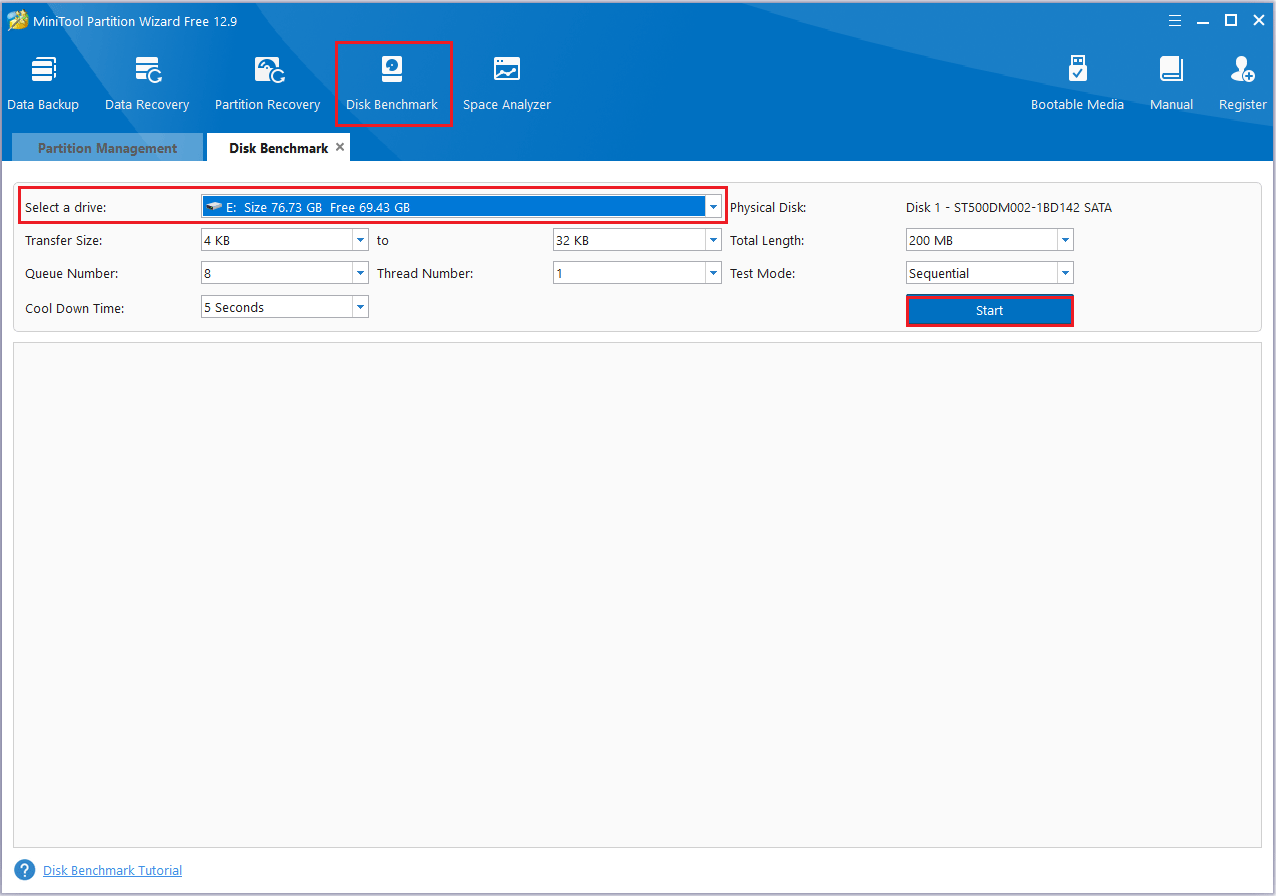
Step 4: After a little time, you will see the test results, including random/sequential reading and writing speed.

#2. Intended Use
Users with different intentions will choose different brands of SD cards. Gamers may care more about random read/write speed, while photographers focus on sustained write speed for burst shooting.
If you need to record 4K 30p video, the Lexar Professional 1800x V60 UHS-II SDXC card is a highly recommended option. Its key features include:
- The Lexar Professional 1800x has the fastest write speed among all V60 cards tested, reaching up to 197 MB/s.
- It also comes with a limited lifetime warranty.
- Read speeds are also impressive. When used with an SDXC-compatible card reader, it can transfer files at over 250 MB/s.
If you’re using an older camera or don’t need top-tier performance, the SanDisk Extreme V30 UHS-I (128 GB) is a budget-friendly option.
- Write speeds are fast for a V30 card. The SanDisk Extreme reached 86 MB/s when copying files.
- At the time of testing, Lexar’s Silver Plus V30 performed slightly better at 93 MB/s, but it was around 40% more expensive than the SanDisk.
If your camera has a CFexpress Type B slot, the SanDisk Extreme Pro (256 GB) is an excellent choice.
The Extreme Pro delivered impressive performance, with write speeds up to 1,299 MB/s and read speeds up to 1,644 MB/s. Among all CFexpress Type B cards tested, it ranked in the mid-range.
#3. Price
Data shows that SanDisk’s memory cards tend to be slightly more expensive than those from Lexar.
In general, the more storage a memory card has, the higher the price.
For example, a 64GB Lexar Professional 2000x UHS-II memory card costs $44.98, while a SanDisk Extreme Pro UHS-II 64GB SDXC memory card costs $59.99 for the same capacity and U rating.
#4. Reliability
Reliability is one of the most important qualities of an SD card. Thanks to technological advances, most modern memory cards are now highly reliable and perform well even in extreme conditions.
The SanDisk Extreme series is known for its reliability. These cards are waterproof, shockproof, temperature-resistant, magnetproof, and X-ray-proof. Their strong performance in harsh environments has made SanDisk a top choice for GoPro users.
Not all Lexar memory cards are waterproof. Although generally reliable, a few have been reported to fail during use.
In terms of reliability, SanDisk will be better than Lexar.
#5. Marketing Positioning
Another difference between Lexar and SanDisk SD cards is their market positioning. See the table below.
| SanDisk | Lexar | |
| Brand Image | Global leading, professional, and reliable | High performance, high cost performance |
| User | From entry-level to advanced | Mainly for mid-to-high-end and professional users |
| Usage scenarios | Professional photography, public storage | Professional photographers, video creators, and cost-effective users |
If you’re a professional photographer, I recommend the following SD card models from Lexar and SanDisk:
- Lexar Professional 2000x / SanDisk Extreme Pro – Excellent performance for 4K/8K video and 3D cameras.
- Lexar Professional 633x / SanDisk Extreme – A great choice for 4K video recording and general photography.
Further Reading:
Lexar SD card:
- Pros: Lexar is frequently recognized for its higher speeds, especially in external SSDs and certain SD cards. The company also provides a lifetime warranty on its microSD cards.
- Cons: Lexar Portable SSDs are more susceptible to heat generation than some SanDisk Portable SSD models, especially under heavy load.
- Best for: This product is ideal for users who need the fastest possible speeds for demanding tasks like video editing or large file transfers.
SanDisk SD card:
- Pros: SanDisk has a strong reputation for creating tough and durable products, especially in its Extreme and Extreme Pro series. These devices are widely appreciated for their dependable performance across a range of environments.
- Cons: SanDisk’s encryption software, Secure Access, may seem less user-friendly and up-to-date when compared to Lexar’s D Shield.
- Best for: This is ideal for users who require a reliable and durable storage solution, particularly those working in harsh environments or needing strong data protection.
Best Software to Manage Your SD Card
After understanding the above information, you will definitely need to manage your new SD card. How to manage it? What software can help you?
The answer is MiniTool Partition Wizard, which is a free partition manager.
It can help you format/create/delete/extend partitions, clone hard drive to SSD, change cluster size, recover hard drive data, and surface test, etc.
The following section introduces the steps for using these features and the common situations in which they are typically applied.
- Create Partition
- Delete Partition
- Format Partition
- Convert MBR to GPT
- Clone Disk
- Wipe Disk
MiniTool Partition Wizard FreeClick to Download100%Clean & Safe
#1. Create Partition
To facilitate your disk management, you can create different partitions to store different types of files.
Here are the steps:
Step 1: Right-click the disk and choose Create.
Step 2: In the new interface, you can customize Partition Label, File System, Drive letter, partition size, etc. Then, click OK.
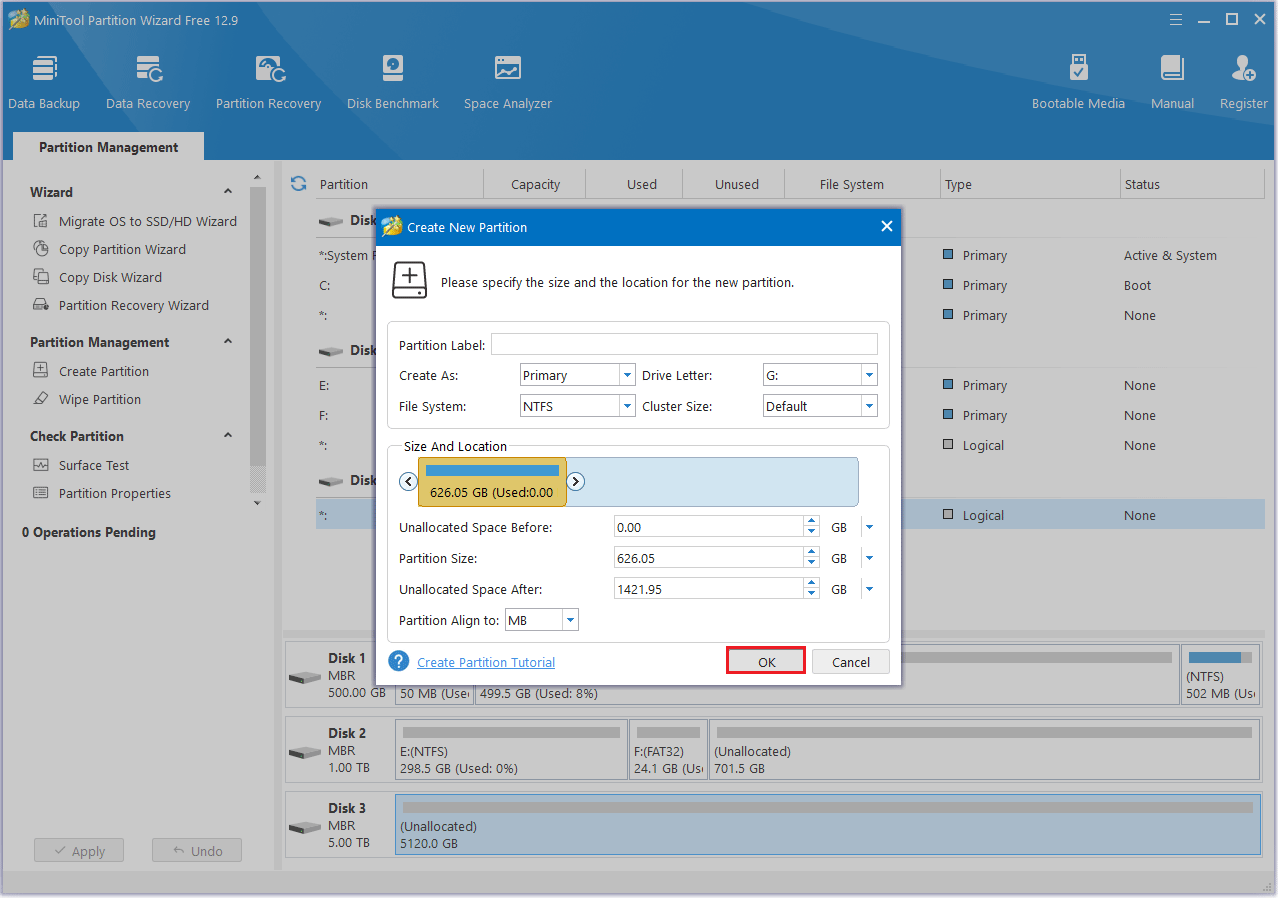
Step 3: Click Apply to finish the process.

#2. Delete Partition
When you want to delete extra partitions you can take the following steps.
Step 1: Open MiniTool Partition Wizard.
Step 2: Right-click the unwanted partition and choose Delete.
Step 3: The original partition becomes unallocated space, and click the Apply button to perform all changes.
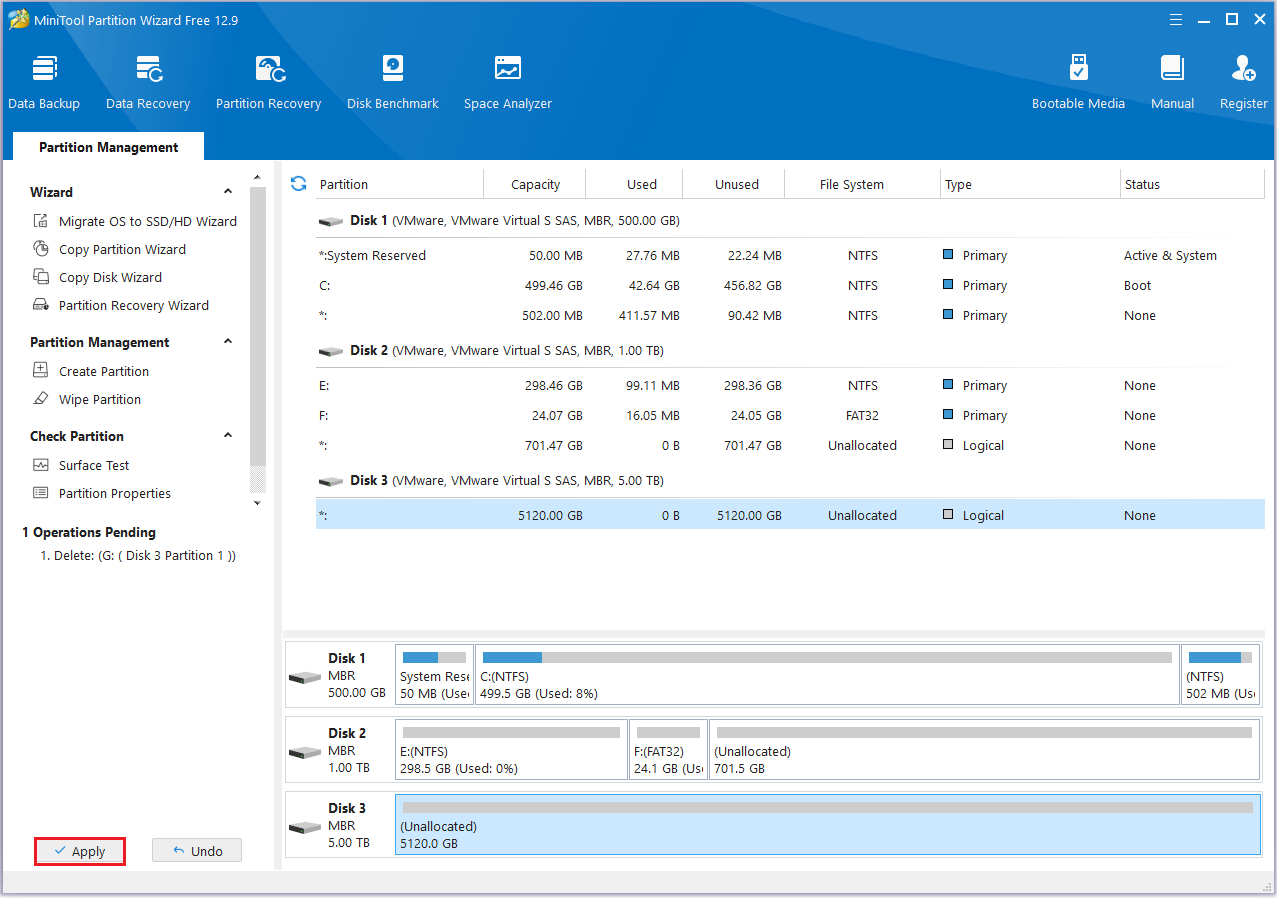
#3. Format Partition
When your partition’s file system is damaged, formatting the partition can fix the errors. Also, if you want to erase all data and make the partition usable again, formatting is necessary.
Step 1: Open this software to get its main interface, and then right-click your SD card from the disk map and click on Format.
Step 2: Select a file system you like from the File System section and click on the OK button to proceed. Here we take FAT32 for example. Also, you can select the desired Cluster Size from here.
Step 3: Click on the Apply > Yes button to execute the formatting operation.
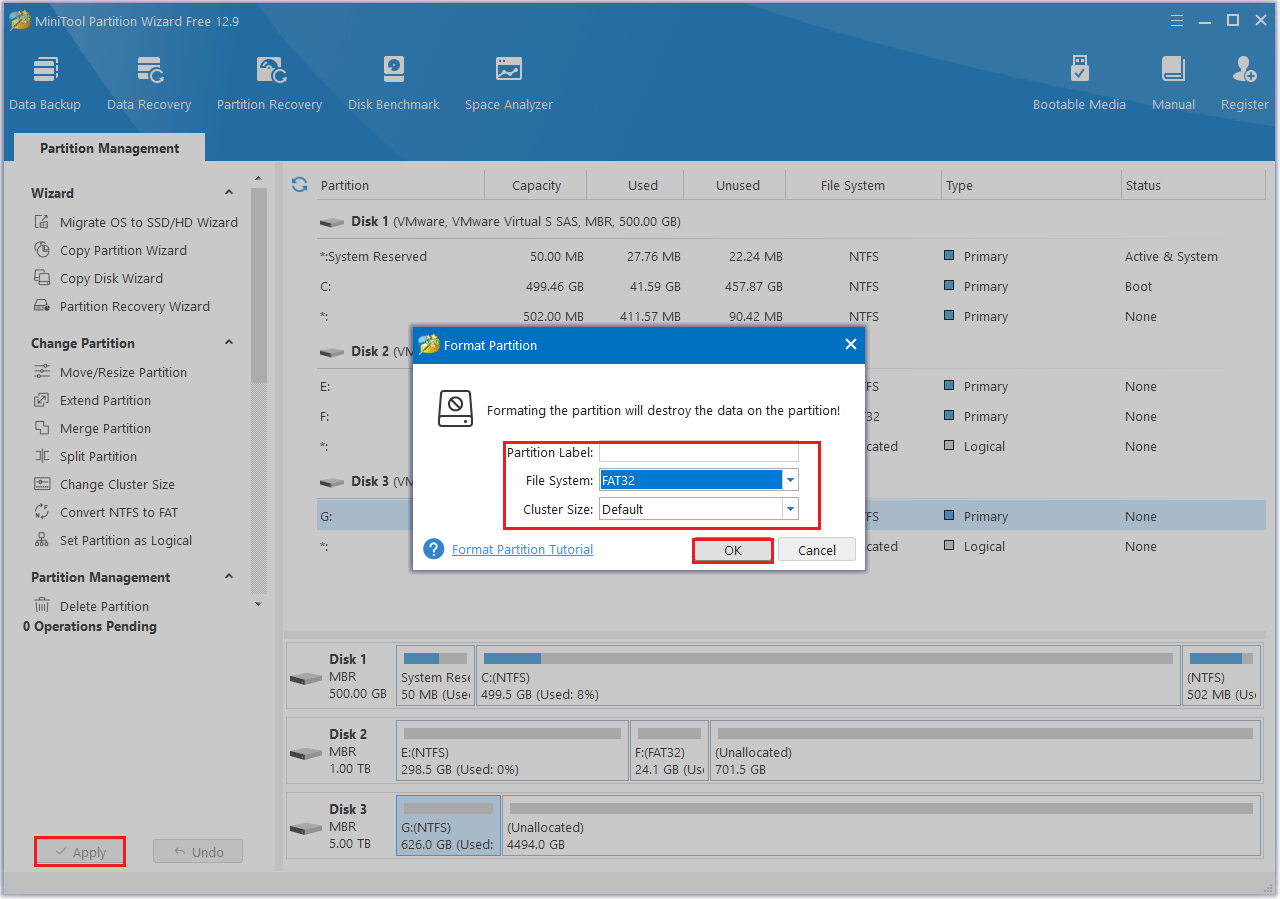
#4. Convert MBR to GPT
If you’re running into limitations with an MBR disk or are concerned about losing important files, converting the disk to GPT can be a good solution.
GPT disks have the following advantages over MBR disks.
1. A GPT disk allows you to create more than four primary partitions.
GPT disks support up to 128 primary partitions, while MBR disks are limited to 4, or 3 primary and 1 extended partition.
2. A GPT disk supports a maximum capacity of 18 exabytes (EB).
A GPT disk supports up to 18EB, while an MBR disk is limited to 2TB. If the disk exceeds 2TB, the extra space will appear as “Unallocated” in Disk Management because Windows only recognizes the first 2TB of an MBR disk.
3. GPT disks are more secure than MBR disks.
If the partition table is damaged, an MBR disk becomes unusable. In contrast, a GPT disk stores a primary GUID partition table header at the beginning and a backup GUID partition table header at the end of the disk. If the primary table is corrupted, it can be restored from the backup.
Here are the steps:
Step 1: Open the MiniTool Partition Mizard to its main interface.
Step 2: Select the target disk and choose Convert MBR Disk to GPT Disk from the left pane.

Step 3: This is a preview of the conversion. Click Apply to proceed.
#5. Clone Disk
If you want to upgrade from an old hard drive to a new one, cloning allows you to copy the system, applications, and data entirely, avoiding the need to reinstall the operating system and software.
Here we take the Clone Disk function of MiniTool Partition Wizard as an example.
MiniTool Partition Wizard DemoClick to Download100%Clean & Safe
Step 1: Open MiniTool Partition Wizard to access the main screen. On this screen, right-click the source disk and choose Copy. Alternatively, you can select Copy Disk from the action panel on the left.
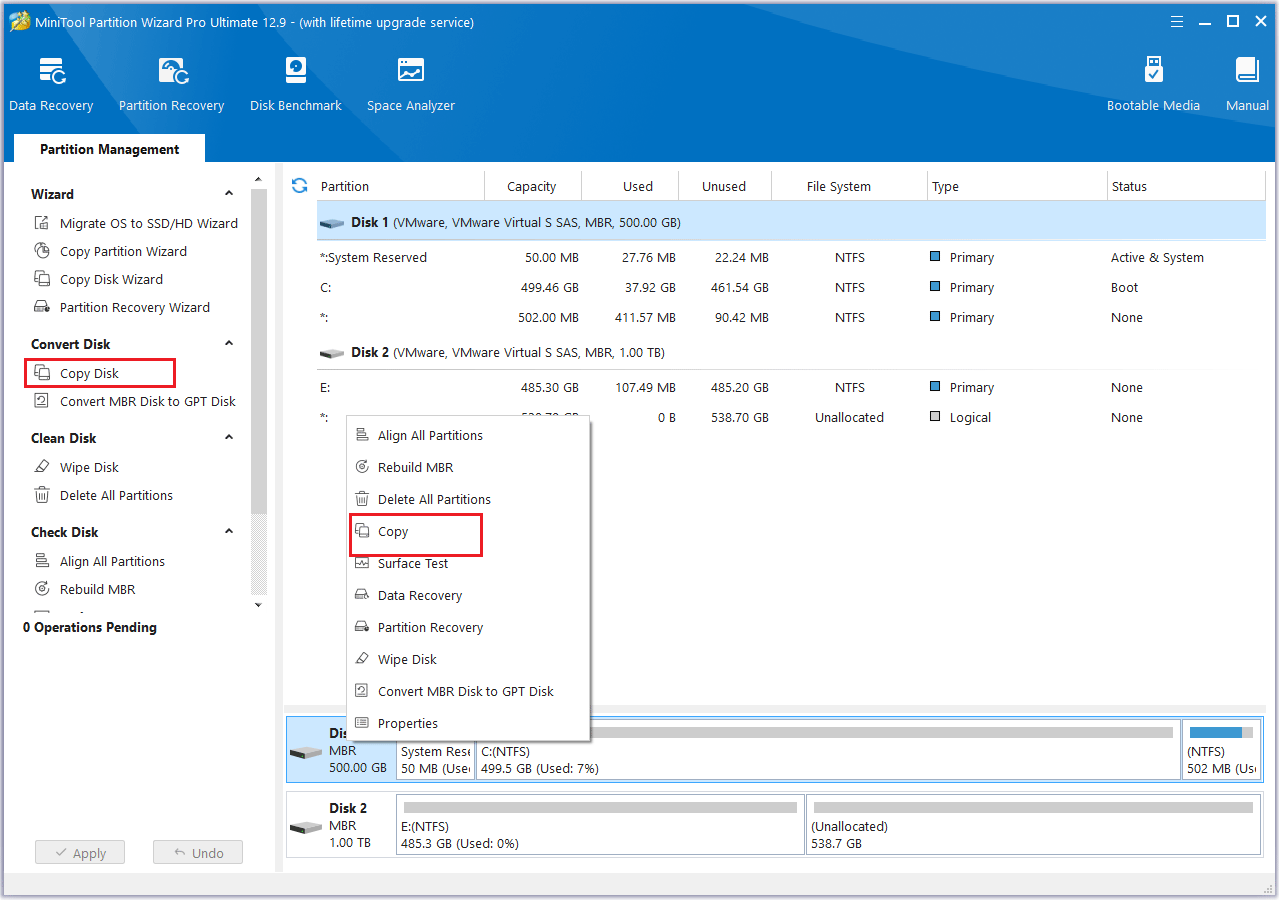
Step 2: In the pop-up window, select the disk as the target disk. Then click Next to continue.
Step 3: Choose a copy method and click Next.
- Fit partitions to entire disk: It fills all disk space on the target disk according to the partition size ratio.
- Copy partitions without resizing: It keeps the original partition sizes. Only available when the target disk is not smaller than the source disk.
- Align partitions to 1MB: The Align partitions to 1 MB option will apply 4K alignment on the SSD.
- Use GUID Partition Table: It turns the target disk into a GPT disk, which is helpful when the target disk is larger than 2TB.
- Change Selected Partition: You can resize or move the partition according to your needs.
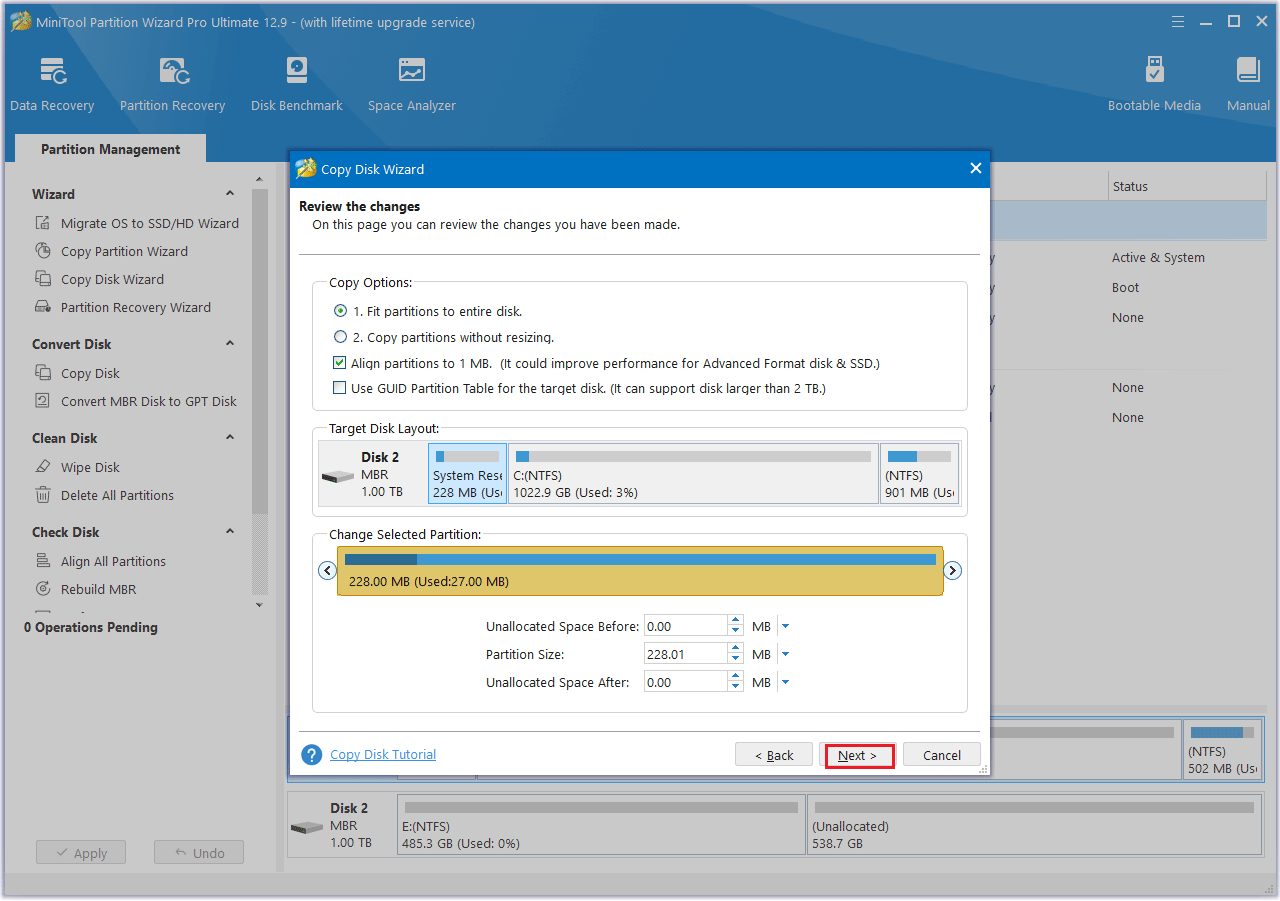
Step 4: An instruction message on how to boot from the target disk will now be displayed. If you are cloning a system disk, make sure to note this information before clicking Finish to continue.
Step 5: To start cloning the hard drive, simply click the Apply button.
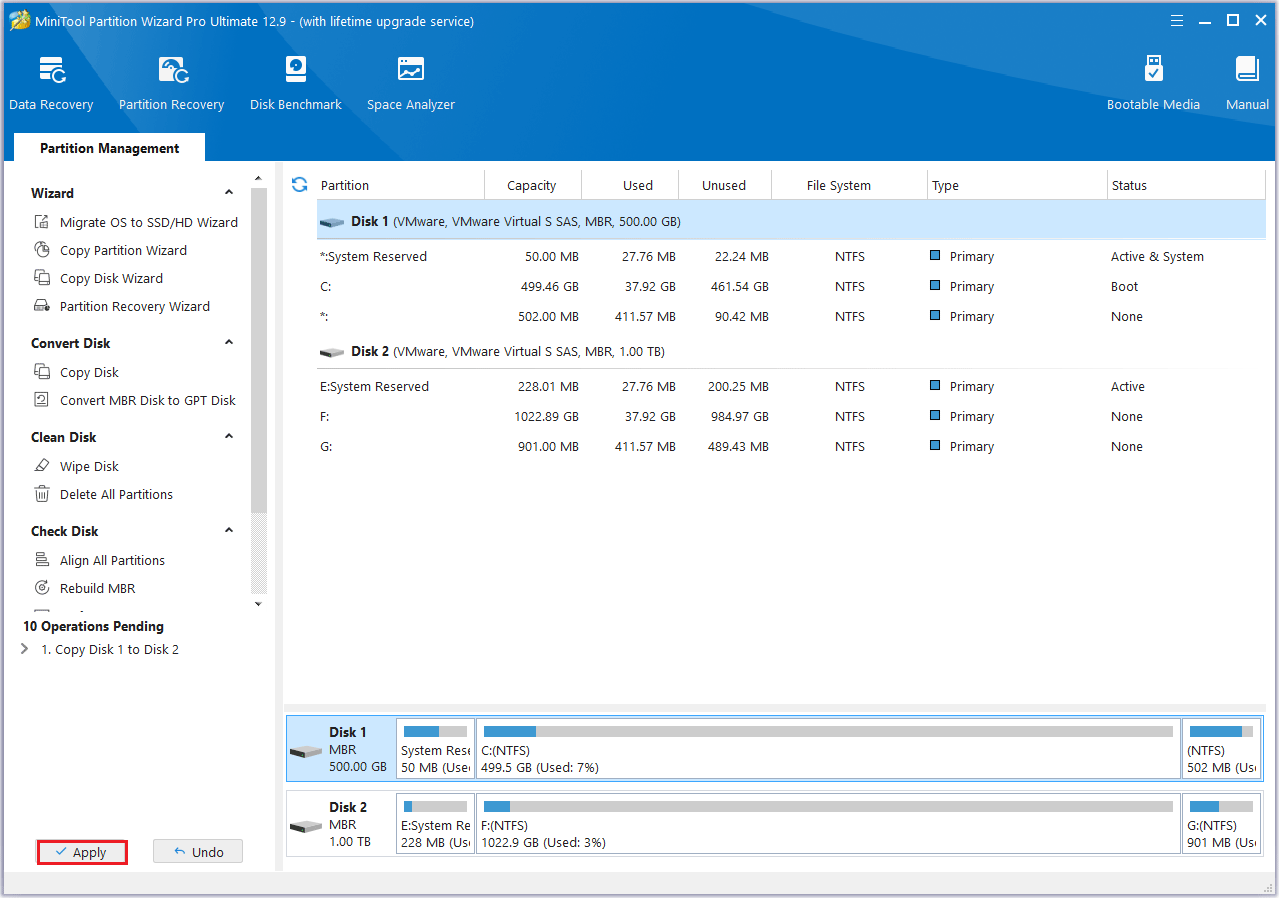
#6. Wipe Disk
The old SSD you swapped out still holds your former data, which might be a concern if you intend to sell or donate it.
What can you do? Use MiniTool Partition Wizard to safely wipe the data.
Follow these step-by-step instructions:
Step 1: Right-click on the disk you wish to wipe and choose Wipe Disk, or select the target disk and click Wipe Disk from the left action panel.
Step 2: A pop-up window like the one below will appear. Choose a wipe method, then click OK to proceed to the next step.
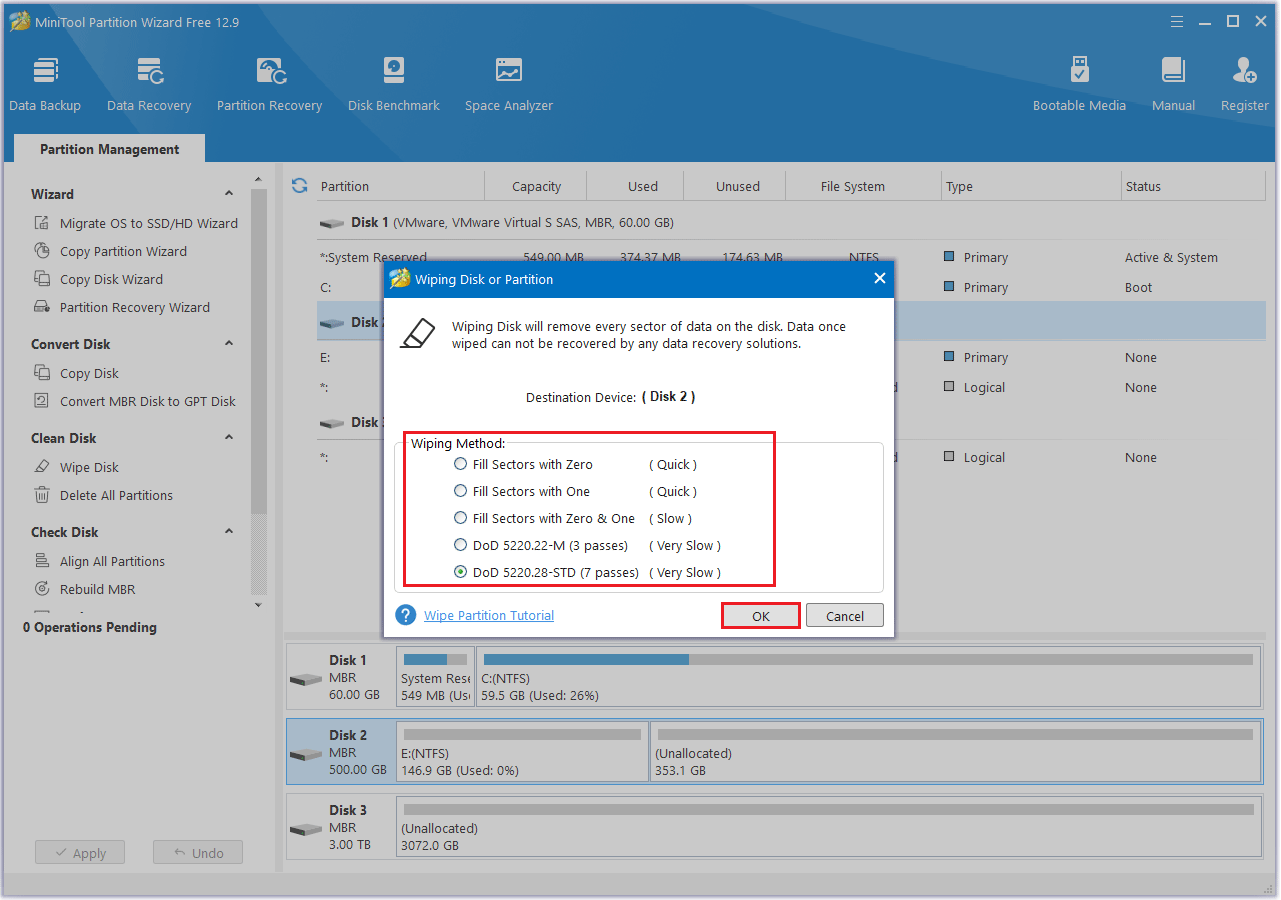
Bottom Line
This article ends here. Now, I believe you have a clear understanding of SanDisk and Lexar SD cards. And also know how to choose these two brands. In addition, you can use MiniTool Partition Wizard to manage your SD card.
If you have any questions or suggestions while using MiniTool Partition Wizard, you can contact us via [email protected] to get a quick reply.




User Comments :